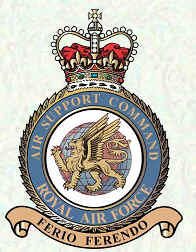| Royal Air Force Air Support Command | |
|---|---|
 | |
| Founded | 1 August 1967- 1 September 1972 |
| Country | |
| Branch | |
| Type | Command |
| Role | support aircraft |
| Headquarters | RAF Upavon |
| Motto(s) | Ferio Ferendo Latin: "I Strike by Carrying" [1] |
| Insignia | |
| crest heraldry | A golden griffon in front of a globe |

Air Support Command of the Royal Air Force was formed on 1 August 1967 by the redesignation of Transport Command. [2] Its change of name reflected the change of emphasis of the Command from solely transporting materials and manpower around the world to providing general support to RAF operations around the world.
Contents
The result of this broader role meant that Air Support Command, unlike its predecessor Transport Command, possessed strike aircraft such as Hawker Hunters. [3] With the contraction of the RAF, it only lasted a short time as a command, and it was absorbed into Strike Command on 1 September 1972 [4] forming No. 38 Group and No. 46 Group within Strike Command. The former was designated as a tactical support and the latter as a strategic support group. [5]
Order of Battle: April 1972 - HQ at Upavon [6]
- RAF Andover
- No. 21 Squadron RAF - Devon, Pembroke
- RAF Benson
- Queen's Flight - Andover, Chipmunk, Heron & Whirlwind
- RAF Brize Norton
- No. 10 Squadron RAF - VC10
- No. 53 Squadron RAF - Belfast
- No. 99 Squadron RAF - Britannia
- No. 511 Squadron RAF - Britannia
- No. 241 Operational Conversion Unit RAF - Belfast, Britannia & VC10
- RAF Coningsby
- No. 228 Operational Conversion Unit RAF - Phantom
- RAF Lyneham
- No. 216 Squadron RAF - Comet
- RAF Northolt
- No. 32 Squadron RAF - Andover, Dominie, Basset & Whirlwind
- RAF Odiham
- No. 240 Operational Conversion Unit RAF - Puma & Wessex
- RAF Thorney Island
- No. 242 Operational Conversion Unit RAF - Andover & Hercules
- RAF Wittering
- No. 233 Operational Conversion Unit RAF - Harrier